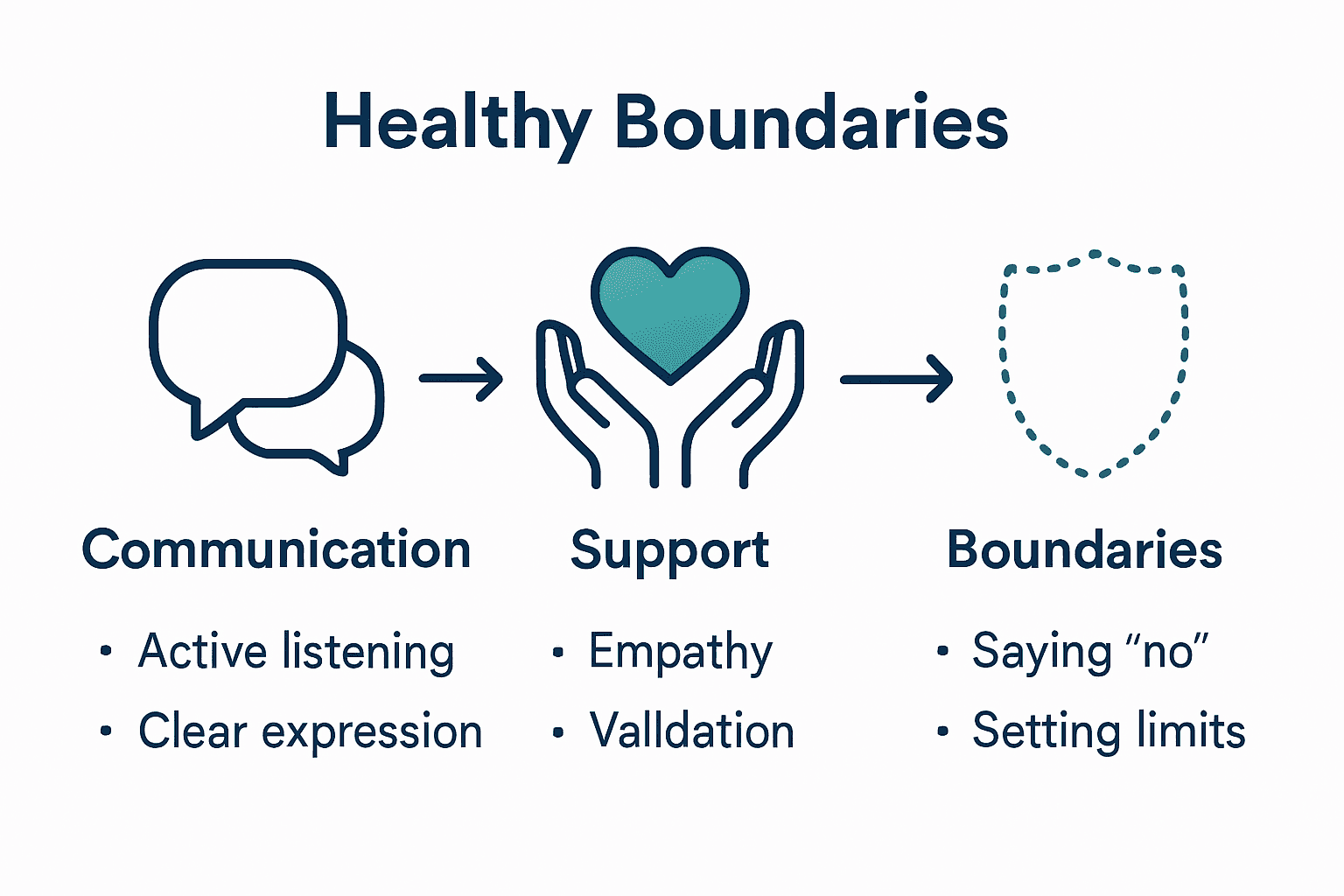Healthy Family Dynamics: Complete Guide for Families
Over half of american adults believe that a healthy family never argues, yet research shows that respectful conflict can strengthen family bonds. Understanding the true nature of family dynamics matters because it shapes everything from daily interactions to long-term well-being. By unpacking common myths and shedding light on what actually supports a thriving home, you can start to build more resilient relationships grounded in empathy and real connection.
Table of Contents
- Defining Healthy Family Dynamics And Myths
- Core Principles Of Functional Family Systems
- Roles And Communication Patterns In Families
- Types Of Conflict And Resolution Approaches
- Warning Signs And Common Family Challenges
- Strategies For Sustaining Healthy Relationships
Key Takeaways
| Point | Details |
|---|---|
| Understanding Healthy Dynamics | Healthy families embrace constructive conflict resolution and adaptability rather than avoiding conflict altogether. |
| Functional Family Systems | Key principles include clear boundaries, collaborative problem-solving, and balanced power dynamics for resilience. |
| Communication Importance | Effective communication involves active listening and respecting individual experiences, creating a supportive family ecosystem. |
| Recognizing Warning Signs | Healthy families identify and address warning signs, such as emotional disengagement and communication breakdowns, proactively to maintain well-being. |
Defining Healthy Family Dynamics and Myths
Healthy family dynamics are complex, interconnected systems that go far beyond simplistic notions of perfection or constant harmony. According to NCBI, family interactions are nuanced, with constructive conflict resolution being a critical component of overall family well-being, not a sign of dysfunction.
Understanding these dynamics requires recognizing that families operate as intricate systems where each member influences and is influenced by others. Iowa State University explains that family systems are characterized by bidirectional influences, meaning individual behaviors and interactions create ongoing feedback loops that shape the entire family’s emotional landscape.
Common myths about healthy family dynamics often misrepresent the true nature of familial relationships. Contrary to popular belief, a truly healthy family is not one that never experiences conflict, but one that handles disagreements with respect, empathy, and open communication. Key characteristics of healthy family systems include:
- Clear and flexible emotional boundaries
- Mutual respect and validation of individual experiences
- Ability to negotiate and resolve conflicts constructively
- Supportive communication that allows for emotional expression
- Adaptability to changing family circumstances
For those seeking deeper insights into managing family interactions, our guide on parenting conflict resolution offers practical strategies for building stronger, more resilient family bonds.
Core Principles of Functional Family Systems
Functional family systems operate on a complex set of interconnected principles that go beyond traditional understanding of family interactions. Files Eric Ed highlights Bronfenbrenner’s ecological systems theory, which emphasizes that families are dynamic environments where members are deeply interdependent and constantly adapting to internal and external challenges.
At the core of functional family systems are clear boundaries and defined roles that allow for both individual autonomy and collective support. According to NACSW, effective communication serves as the primary mechanism through which families maintain these boundaries while fostering resilience and mutual understanding. These systems are characterized by their ability to flexibly respond to changing circumstances without losing their fundamental sense of connection and shared identity.

Key principles of functional family systems include:
- Mutual emotional support and validation
- Adaptable communication strategies
- Balanced power dynamics
- Respect for individual differences
- Collaborative problem-solving approaches
Families seeking to strengthen their systemic interactions might find practical insights in our guide on handling parenting conflicts, which offers strategies for maintaining healthy family dynamics through constructive dialogue and mutual understanding.
Roles and Communication Patterns in Families
Family communication is far more than simple verbal exchanges. Eric Files reveals through the Circumplex Model that family communication operates as a complex, multidimensional system involving intricate patterns of interaction, emotional connectivity, and systemic dynamics. These communication patterns fundamentally shape how family members understand, support, and relate to one another.
Roles within families are not static but dynamic constructs that evolve with changing circumstances and individual development. Each family member contributes to a complex communication ecosystem where messages are continuously transmitted, interpreted, and responded to. Effective families develop flexible roles that allow individuals to adapt, grow, and support each other while maintaining clear boundaries and mutual respect.
Key communication patterns in healthy family systems include:
- Active and empathetic listening
- Expressing emotions constructively
- Validating individual experiences
- Maintaining respectful dialogue
- Resolving conflicts collaboratively
- Balancing support with individual autonomy
For families looking to improve their communication strategies, our guide on handling parenting conflicts provides practical techniques for developing more meaningful and supportive interactions.
Types of Conflict and Resolution Approaches
NCBI research reveals that family conflicts are not monolithic but exist across a spectrum of complexity, ranging from minor disagreements to profound systemic challenges. Understanding these conflict typologies is crucial for developing targeted resolution strategies that address the unique dynamics of each family interaction.
According to Iowa State University, family systems theory emphasizes that conflicts emerge from interconnected relational patterns rather than isolated incidents. The most common types of family conflicts include:
- Intergenerational Conflicts: Disputes between different age groups
- Role-Based Conflicts: Disagreements about family responsibilities and expectations
- Communication Breakdown Conflicts: Misunderstandings and communication gaps
- Value and Belief Conflicts: Differences in fundamental worldviews
- Resource Allocation Conflicts: Disputes over shared resources and financial decisions
Resolution approaches require a nuanced, systemic approach that prioritizes understanding, empathy, and collaborative problem-solving.
When traditional strategies prove challenging, families can benefit from professional guidance to navigate complex relational dynamics. For comprehensive strategies tailored to specific conflict scenarios, our guide on conflict resolution steps offers practical insights for families seeking meaningful resolution.
Warning Signs and Common Family Challenges
NCBI research reveals that healthy families are not defined by the absence of challenges, but by their ability to recognize and constructively address warning signs before they escalate. Persistent unresolved conflicts represent a critical indicator of potential systemic family dysfunction, signaling deeper relational patterns that require immediate attention and intervention.
According to Iowa State University, family systems are complex ecosystems where challenges often manifest through subtle yet significant behavioral patterns. The most critical warning signs include:
- Emotional Disengagement: Consistent lack of emotional connection
- Communication Breakdown: Persistent misunderstandings and communication gaps
- Boundary Violations: Inappropriate personal or emotional intrusions
- Unresolved Generational Patterns: Repetitive destructive behaviors
- Power Imbalances: Unhealthy control dynamics between family members
Families experiencing these challenges can benefit from professional guidance and targeted interventions. For those seeking deeper insights into understanding and managing family dynamics, our article on anger issues and family patterns provides valuable perspectives on recognizing and addressing complex familial challenges.
Strategies for Sustaining Healthy Relationships
Healthy relationships require intentional, dynamic strategies that evolve with changing family dynamics. Eric Files research emphasizes the critical balance between family cohesion and flexibility, highlighting that sustainable relationships are not about rigid perfection, but adaptive connection.
Successful relationship maintenance involves multiple interconnected approaches. Families must develop communication techniques that promote mutual understanding, respect individual differences, and create spaces for genuine emotional exchange. The most effective strategies include:

- Practicing active and empathetic listening
- Establishing clear and respectful boundaries
- Encouraging open and non-judgmental dialogue
- Creating regular opportunities for shared experiences
- Developing mutual problem-solving skills
- Maintaining individual identities within family contexts
Navigating relationship complexities requires ongoing commitment and sometimes professional guidance. For couples and families seeking deeper insights into building strong relational foundations, our guide on healthy relationship signs offers comprehensive strategies for nurturing meaningful connections.
Take Charge of Your Family’s Well-Being Today
Navigating the complexities of healthy family dynamics can feel overwhelming, especially when dealing with challenges like emotional disengagement or unresolved conflict. This guide highlights how crucial clear communication, respect, and adaptable roles are for sustaining supportive family relationships. If you recognize these struggles in your own family or want to strengthen your bond through proven conflict resolution techniques, you are not alone.

At Mastering Conflict, we specialize in professional mental health and conflict resolution services tailored for families seeking real change. Our experts offer counseling, coaching, and anger management strategies designed to help you restore emotional connection and build lasting trust. Don’t wait until warning signs become deeper issues—explore practical solutions now in our parenting conflict resolution guide and deepen your understanding with our comprehensive conflict resolution steps. Begin your family’s journey toward healthier dynamics. Visit Mastering Conflict and take the first step to transforming your family relationships today.
Frequently Asked Questions
What are healthy family dynamics?
Healthy family dynamics refer to the complex interactions and relationships between family members characterized by mutual respect, effective communication, constructive conflict resolution, and emotional support.
How can families improve their communication patterns?
Families can improve their communication patterns by practicing active listening, expressing emotions constructively, maintaining respectful dialogue, and ensuring that every member’s experiences are validated.
What are common types of family conflicts?
Common types of family conflicts include intergenerational conflicts, role-based conflicts, communication breakdowns, value disagreements, and resource allocation disputes.
What warning signs indicate a need for intervention in family dynamics?
Warning signs include emotional disengagement, persistent communication breakdowns, boundary violations, unresolved generational patterns, and imbalances in power dynamics.
Recommended
- How to Deal With Parenting Conflicts
- Parenting Conflict Resolution: Steps for Healthier Family Bonds – Mastering Conflict
- Navigating Family Conflict for Positive Relationships – Mastering Conflict
- 7 Key Signs of a Healthy Relationship Everyone Should Know – Mastering Conflict
- Building Healthy Habits Naturally: A Step-by-Step Guide – naturessoulshop
- Family Communication Tips: Complete Guide for Households – BLUSHBEES USA

